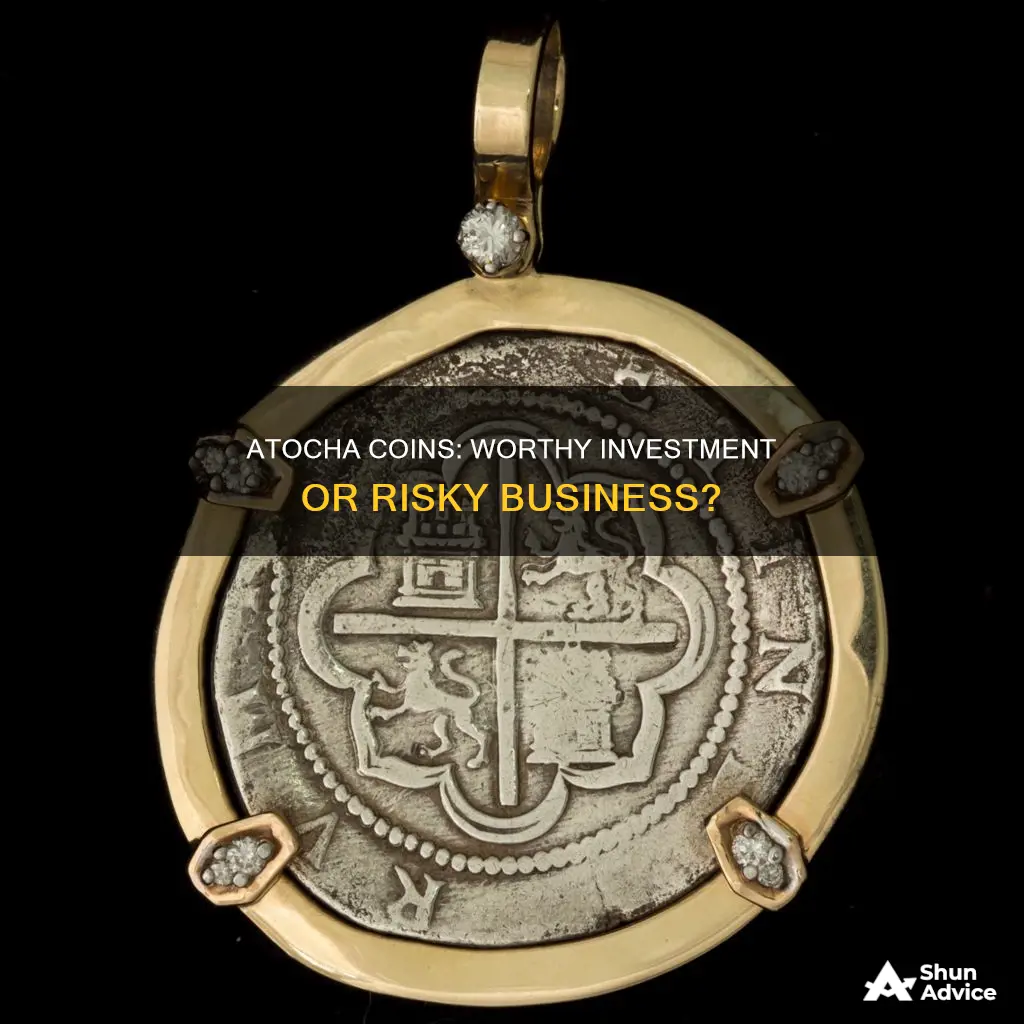
Atocha coins are gold and silver coins that were part of the cargo of the ship Nuestra Senora de Atocha, which belonged to King Philip IV's Tierra Firme fleet. The ship left Havana for the New World of Spain in 1622, carrying tons of treasure, including 40 tons of silver and gold, Venezuela pearls, and Colombian emeralds. Unfortunately, the heavily laden ship sank in a hurricane near the Florida Keys, and the treasure remained undiscovered for 300 years until it was found by Mel Fisher and his team of divers in 1985. The coins from the Atocha vary in grade depending on their condition, with Grade 1 being the least damaged and Grade 4 being the most damaged. The coins are valuable to collectors and are often used in jewellery due to their historical significance. With an estimated value of $400 million, the Atocha is considered the most valuable shipwreck in history, making its coins a potentially good investment for those interested in historical antiques.
| Characteristics | Values |
|---|---|
| Rarity | The Nuestra Senora de Atocha is a rare ship, belonging to King Philip IV's Tierra Firme fleet. |
| Historical Value | The coins are valuable historical artefacts, being part of the "most valuable shipwreck" in history. |
| Authenticity | Atocha coins are often faked, so buyers should look for a Certificate of Authenticity from the Mel Fisher organisation. |
| Grading | The coins are graded based on their condition, with Grade 1 being the least damaged and Grade 4 being the most damaged. |
| Price | The price of an Atocha coin depends on its grade and the extent of any damage. Grade 1 coins are valued at around $1595-$2500, Grade 2 coins at around $1095, Grade 3 coins at around $995, and Grade 4 coins vary depending on how much of the coin is left. |
| Demand | Atocha coins are in high demand among collectors. |
| Weight | The weight of an Atocha coin can help identify its authenticity, as the weight was affected by saltwater. |
| Material | Atocha coins are made of gold or silver. |
| Use in Jewellery | Atocha coins, or pieces of them, are often used in jewellery such as pendants, earrings, bracelets, rings, and cuff links. |
What You'll Learn

Authenticity of Atocha coins
The authenticity of Atocha coins is a key concern for collectors, given the existence of very good replica coins. Collectors should be aware of the manufacturing process of original coins, which were struck on crude planchets with crude dies, leaving irregular but crisp details and cracked or mottled edges. Replica coins, by contrast, are often made using a lost wax casting process, resulting in surface bubbles, rounded lines of detail, and mould lines around the edges. Additionally, replica coins are typically about 10% lighter than genuine treasure coins.
When purchasing Atocha coins, it is essential to deal with reliable professionals who can guarantee the authenticity of the coins they sell. Certificates of authenticity are crucial, and buyers should ensure they receive one with their purchase. These certificates should include information such as the identification of the coin, its mint and assayer (if known), and its age. A high-security certificate of authenticity is provided by Mel Fisher's Treasures, the company that discovered the Atocha shipwreck, for any artefacts recovered by their divers and sold through their official web store.
Collectors can also look out for specific details that indicate the authenticity of the coins. For example, Atocha coins, also known as "cobs," tend to have crude, irregular edges due to the handmade nature of their creation. However, some of the first coins minted in the New World by indigenous artisans trained in the Spanish style may exhibit exquisite craftsmanship.
The reputation of the seller is also an important consideration. Dealing with established companies or individuals with extensive experience in the field, such as Mel Fisher or his family, can provide an additional layer of assurance regarding the authenticity of the coins.
The Best Crypto Coin to Invest in Now
You may want to see also

Grading of Atocha coins
Atocha coins are graded based on a few factors, including the amount of saltwater damage, the visibility of details, and the overall condition of the coin. The grades range from Grade 1 to Grade 4, with Grade 1 being the highest quality.
Grade 1 coins are salvaged from the interior of the treasure chest, resulting in minimal saltwater damage. These coins typically have clear and visible details on both the obverse and reverse sides, including the mintmark, assayer mark, and denomination. Grade 1 coins are also known for their weight and large diameter, which further enhances the visibility of the legends and designs around the edges.
Grade 1+ coins are an even higher tier within the Grade 1 category. These coins exhibit exceptional details, such as a full and well-centred cross or shield, with all lions and castles visible in the cross quadrants. The mint and assayer marks are also bold and distinct.
Grade 2 coins, on the other hand, may show more signs of saltwater corrosion and have less visible details. The legends and designs might be partially obscured, and the overall condition may not be as pristine as Grade 1 coins.
Grade 3 and Grade 4 coins represent the lower grades, with more significant saltwater damage, less visible details, and a generally more worn appearance. These coins may have flatness or double-struck areas that affect the clarity of the designs and legends.
It is important to note that the grading of Atocha coins can vary slightly depending on the specific seller or grading service. Additionally, the grading may also take into account the rarity and historical significance of the coin, especially if it is associated with a specific shipwreck or has a unique mintmark or assayer mark.
Overall, the grading of Atocha coins provides collectors and investors with a way to assess the condition and value of these historic artefacts. Grade 1 and Grade 1+ coins are considered the most desirable due to their superior condition and level of detail, while Grades 2, 3, and 4 represent varying degrees of wear and corrosion.
The Bitcoin Investment Trust: A Comprehensive Guide
You may want to see also

Value of Atocha coins
The value of Atocha coins is influenced by their historical significance, rarity, and the overall value of the treasure recovered from the shipwreck. The coins were part of the treasure recovered from the shipwreck of La Nuestra Senora de Atocha, which sank near the Florida Keys in 1622. The ship was part of the Tierra Firme Fleet, carrying treasure and trade goods from Havana, Cuba, to Spain.
The value of the coins can be seen in the prices they fetch at auctions and specialist stores. For example, an Atocha 1622 shipwreck 4 Reales coin with a Mexico mint and a grade of 2 can be priced at $6,600. The price varies depending on the grade, mint, and weight of the coin. An 8 Reales coin from the same shipwreck, with a grade of 3 and weighing 21.10 grams, is priced at $3,500. The same coin with a higher grade of 1 and weighing 24.7 grams is priced at $5,100.
The coins are known as "cobs" by collectors, derived from the Spanish "Cabo de Barra", or "End of the Bar", referring to the technique used to create these handmade coins. The handmade nature of the coins contributes to their unique characteristics, such as crude and irregular edges. Despite their irregularity, some of the first coins minted in the New World were crafted by indigenous artisans trained in the Spanish style, resulting in exquisite pieces.
The overall value of the treasure recovered from the Atocha shipwreck is estimated to be worth $450,000,000, with a large portion still undiscovered, according to the ship's manifest. This adds to the allure and potential future value of the coins as a rare and historical investment.
Coinbase Investing: A Beginner's Guide to Getting Started
You may want to see also

Identifying fake Atocha coins
Atocha coins are valuable relics and collectors' items, so it is important to be able to identify genuine coins from fakes. Here are some ways to do that:
Firstly, it is important to note that genuine Atocha coins are not sold at heavily discounted prices. If you see a coin being sold at 80% off, it is likely a scam. Similarly, no one would destroy an authentic silver bar from the Atocha to create replica coins. So, if you come across such an offer, it is likely a fake.
Secondly, genuine Atocha coins were originally weighed in reales, with each real divided into onzas, which equalled 28 grams. The following denominations were created: 8 reales, 4 reales, 2 reales, 1 real, ½ real, and ¼ real. Each was intended to be half the weight of the preceding denomination. So, if the weight of the coin you are examining is significantly off, it may be a fake. However, do note that saltwater influenced the weight of the currency, and corrosion and sea abrasion can also affect the weight.
Thirdly, the Mel Fisher organisation offers a Certificate of Authenticity that can help identify a genuine Atocha coin. If you are unsure about a coin, you can reach out to the Mel Fisher Maritime Heritage Society and Museum in Key West, Florida, for their opinion.
Finally, genuine Atocha coins are known by collectors as "cobs", which is a loose translation of "Cabo de Barra" or "End of the Bar". This refers to the technique used to create these handmade coins. So, if a coin is being sold as an Atocha coin but does not match the description of a "cob", it may be a fake.
In summary, by being vigilant, aware of the characteristics of genuine Atocha coins, and cautious of scams, you can increase your chances of identifying fake Atocha coins.
The Ultimate Guide to Investing in Dogecoin
You may want to see also

Atocha coins in jewellery
Atocha coins are a popular choice for jewellery, with many retailers offering a range of necklaces, pendants, earrings, and rings featuring the coins. The coins are often set in gold or silver, and may be accompanied by other precious stones such as diamonds, emeralds, and garnets. The coins are typically sold with a certificate of authenticity, and some are even custom-made or handmade.
Atocha coins are desirable in jewellery because of their historical significance. The coins originate from the Nuestra Senora de Atocha, a heavily laden Spanish treasure galleon that sank in a storm near the Florida Keys in 1622. The ship was part of the Tierra Firme Fleet, which was heading to Spain from Havana with trade goods and treasures. An estimated $450,000,000 worth of Spanish treasure was recovered from the shipwreck in the 1980s, though a large portion of the treasure is yet to be found.
The coins themselves are known by collectors as "cobs", a loose translation of "Cabo de Barra", or "End of the Bar", referring to the technique used to create these handmade coins. They are often crude and irregular on the edges, though some of the first coins minted in the New World were exquisitely created by indigenous artisans trained in the Spanish style.
Atocha coin jewellery is available from a variety of retailers, including specialist treasure stores, Amazon, and Etsy. Prices range from $22.87 to $2,950, depending on the quality and rarity of the coin, as well as the materials used in the jewellery setting.
Exploring Bitcoin's Potential: A Small Investment's Big Adventure
You may want to see also
Frequently asked questions
Yes, Atocha coins are a good investment. They are valuable pieces of history, with a fascinating story behind them. The coins are made from gold and silver and were part of the cargo of the ship Nuestra Senora de Atocha, which sank in 1622. The ship was carrying tons of treasure, including gold, silver, Venezuela pearls, and Colombian emeralds. The coins are also used in jewellery, which makes them even more desirable and increases their value.
The value of Atocha coins comes from their history and the story of how they were discovered. They are also graded based on their condition, with Grade 1 coins being the most valuable as they were retrieved from the innermost part of the treasure chest and were not damaged by saltwater.
Atocha coins are available for purchase from specialist websites such as Mel Fisher's Treasures, Shipwreck Treasures of the Keys, and Atocha.com.







